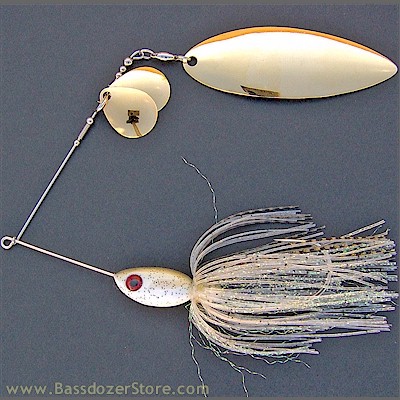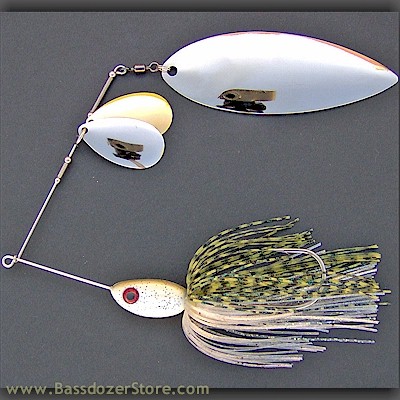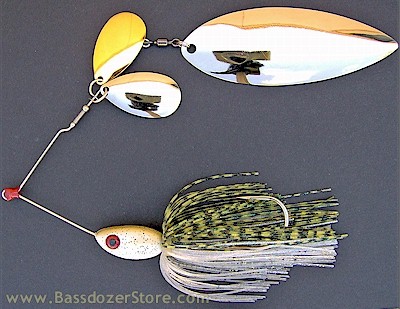Bassdozer's Spinnerbaits for Burning and
Bulging Big Bass and Pike

by Russ Bassdozer
This shows and tells product photos, product descriptions and
information for the lure models and colors that are (or have
been) available at BassdozerStore.com. Not all models and colors
shown are currently available, and exact specifications are
subject to change.
Note: Some of the following configurations may not all be
currently in stock. Some may be sold out at this time. Please
check online at www.BassdozerStore.com
for current availability of specific items below. Thank you for
your business.
Bassdozer's Spinnerbaits for Burning and Bulging Big Bass and
Pike
Until now, anglers have had to settle for burning or bulging
spinnerbaits on or close to the water's surface using ordinary
spinnerbaits not designed to do that.
Now, Bassdozer's Store is pleased to offer the very latest in
big bass and pike spinnerbaits optimized for burning and bulging
the water!
It may look like an ordinary spinnerbait below, but the photos
are deceptive, and you cannot gauge the true scale of this
monster spinnerbait dressed with some of the biggest Willow
blades available on the planet. A specialized rod is ideally
required to handle these massive spinnerbaits. The G. Loomis rod
model #SBR864 is one example that will handle such baits. With
heavy baitcasting applications such as this, I am a big fan of
the Shimano Chronarch CH100B reel with any and all heavy
baitcasting tactics. Any lighter reel will grind down and
self-destruct. A minimum of 16 pound test Yamamoto Sugoi grey
fluorocarbon line (for example) is required to handle such
spinnerbaits. Any lighter rod or lighter line won't let you
comfortably cast such big spinnerbaits.
Bottom line, if the rod or line makes you feel you could snap
the rod or line; if you can only lob the spinnerbait out there in
baby casts, or if the reel is buckling, you are under-equipped
here.
It's also among the most physically exhausting tactics to burn
or bulge such big spinnerbaits, and you need to exercise caution
and common sense without overexerting yourself with this extreme
fishing tactic.
Dual Interlaced Front Blades
On the bait shown below, the dual clevis set-up is something
that's very popular nowadays on inline musky/pike spinners -
especially for "bulging" the surface with inline
spinners. However, the dual clevis set-up works swell on a big
spinnerbait too. It is especially attractive when the spinnerbait
stalls, is paused or helicopters, it just seems a lot of action
is made due to the dual clevis set-up.

1 oz Spinnerbait ~ Style C ~ Gold Shiner Flash
Fast Burner Spinnerbait. The Style C shown above
has a ball bearing swivel, a huge yet streamlined #7 Willow
blade, and dual clevis Colorado blades. You have your fast burner
here. This is one I favor for pulling smallmouth up to the
surface off deep points and ledges where you can sometimes see
the bottom in 25 feet of water. I don't often try to bulge this,
but burn it as fast as possible below the surface. It's truly
stable and smooth without an inordinate heap of torque. Still, it
will wear you out quickly.
The dual Colorado front blades really flare out and whir. I
like to puff the blades once in a while with a rod pull without
slowing down. This gives a desirable change of action without
slowing down. Sometimes slowing down can cause chasing fish to
turn away and break off the chase when burning blades.

1 oz Spinnerbait ~ Style C ~ Green Shiner
I picked up the dual interlaced front blade concept from
seeing in-line musky/pike spinners. This kind of double clevis
configuration is used alone (no other blades) on in-line
musky/pike spinners and it is called a "bulging" blade
set-up by musky anglers.Musky spinners sport tremendously huge
dual bulging blades. However, in-line musky spinners don't have
the big trailing Willow like you see here. Two identical
size/shape (often different finish) blades are paired up front on
musky/pike spinners.
It seems this dual clevis is not used much on musky/pike
spinnerbaits - really only on in-line spinners. Nevertheless,
I've found the dual clevis set-up works good the way you see it
here for bass spinnerbaits. What I've done to adapt the concept
for bass spinnerbaits is::
- I've downsized the dual clevis front blades
- I've added the giant #8 Willow back blade, which is the
largest available sizes Willow blade on Earth.
I also use a barrel swivel here. This is another tip I've
picked up from musky/pike spinnerbaits, which are often made with
barrel swivels instead of ball bearing swivels. Musky/pike
spinnerbaits often use a barrel swivel in order to make the big
back blade work harder, vibrate more and lift more, among other
things. On the spinnerbait you see here, I feel the barrel swivel
slows the Willow revolution, makes it work harder to turn, and
therefore makes it lift more. The double Indiana blades lift it
even higher. The entire three blade set-up makes the spinnerbait
ride up high real slow and easy. It bulges the surface of the
water easily (compared to more familiar set-ups like double
Willows). The bulge looks like the Loch Ness monster is about to
emerge and reveal itself.
It's as effective without making a visible surface bulge -
what I call "slow burning" it less than a foot below
the surface. Please enjoy!

1 oz Spinnerbait ~ Style C ~ Green Shiner
Shown above are two optional modifications that you don't
really need to make - but they may enhance the performance of
this (or any) big spinnerbait. These are optional steps if you
want to take them yourself:
- First, you can put a slight z-bend in the wire, and that
helps keep the blades up the arm and away from where the line is
tied. So the blades can't drop down below the z-bend toward where
they could foul the fishing line. I've found the fishing line
fouls in big blades on big spinnerbaits more often than the line
fouls with standard size spinnerbaits. Especially when the front
blades slide down near tthe line tie, they foul the line. This
particular spinnerbait comes with a close-fitting bead and sleeve
ahead of the clevis, which helps keep the other parts high up on
the wire when a z-bend is made. Keep in mind, don't make the
z-bend so close to the parts that you constrict their
free-turning movement.
- Second, you can use some heat shrink tubing and shrink it
down over the twisted wire loop eye, which will help prevent the
line from getting caught in the wire loop. I use red heat shrink
tubing here, but black or any color is okay.
|
